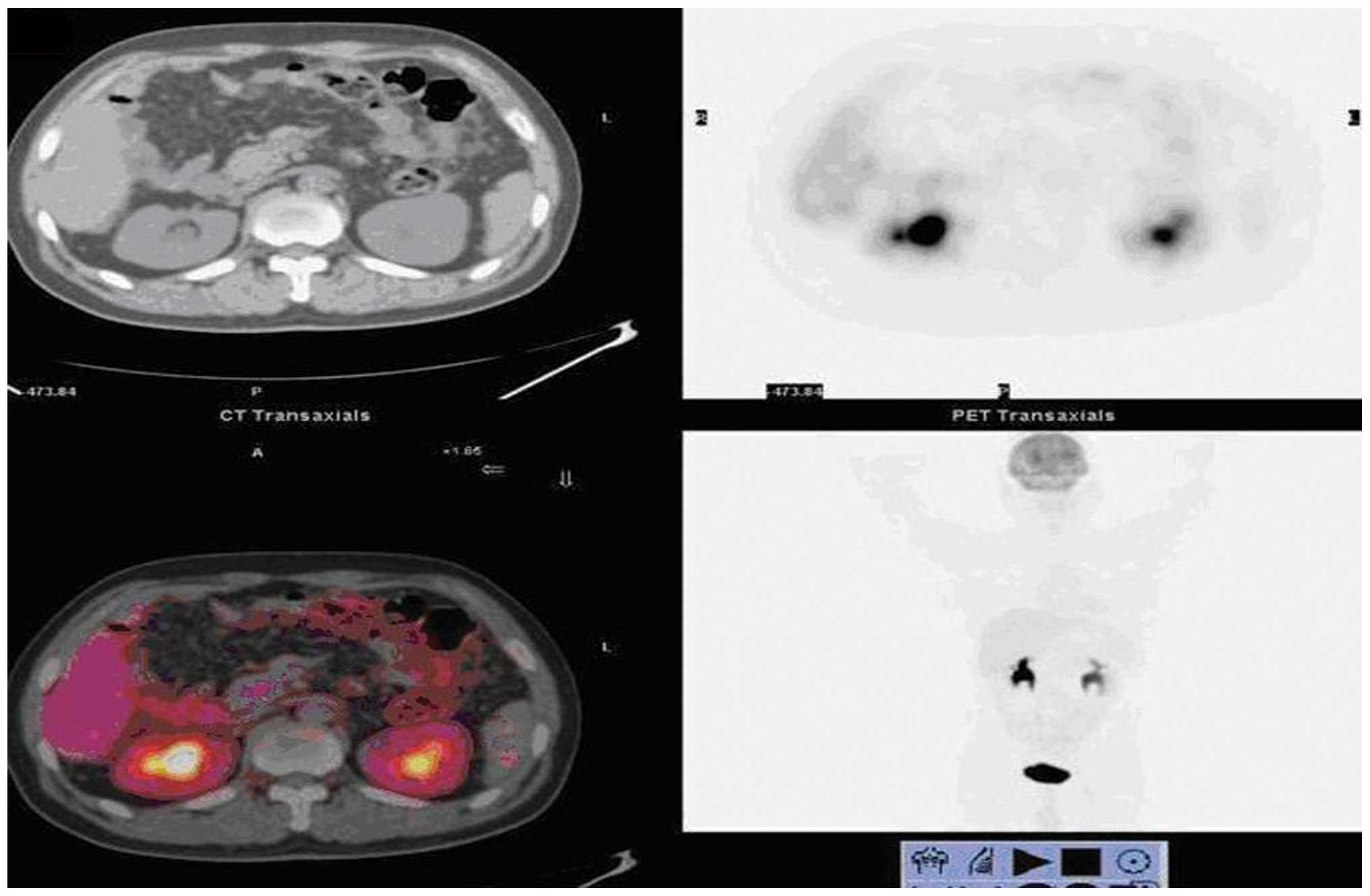|
1
|
Desch CE, Benson AB III, Somerfield MR, et
al; American Society of Clinical Oncology. Colorectal cancer
surveillance: 2005 update of an American Society of Clinical
Oncology practice guideline. J Clin Oncol. 23:8512–8519. 2005.
|
|
2
|
Elias D, Sideris L, Pocard M, et al:
Results of R0 resection for colorectal liver metastases associated
with extrahepatic disease. Ann Surg Oncol. 11:274–280. 2004.
|
|
3
|
Lin JK, Lin CC, Yang SH, et al: Early
postoperative CEA level is a better prognostic indicator than is
preoperative CEA level in predicting prognosis of patients with
curable colorectal cancer. Int J Colorectal Dis. 26:1135–1141.
2011.
|
|
4
|
Dirisamer A, Halpern BS, Flöry D, et al:
Performance of integrated FDG-PET/contrast-enhanced CT in the
staging and restaging of colorectal cancer: comparison with PET and
enhanced CT. Eur J Radiol. 73:324–328. 2010.
|
|
5
|
Zhang C, Chen Y, Xue H, et al: Diagnostic
value of FDG-PET in recurrent colorectal carcinoma: a
meta-analysis. Int J Cancer. 124:167–173. 2009.
|
|
6
|
Zhang Y, Feng B, Zhang GL, et al: Value of
18F-FDG PET-CT in surveillance of postoperative
colorectal cancer patients with various carcinoembryonic antigen
concentrations. World J Gastroenterol. 20:6608–6614. 2014.
|
|
7
|
Panagiotidis E, Datseris IE, Rondogianni
P, et al: Does CEA and CA 19–9 combined increase the likelihood of
18F-FDG in detecting recurrence in colorectal patients with
negative CeCT? Nucl Med Commun. 35:598–605. 2014.
|
|
8
|
Makis W, Kurzencwyg D and Hickeson M:
18F-FDG PET/CT superior to serum CEA in detection of colorectal
cancer and its recurrence. Clin Imaging. 37:1094–1097. 2013.
|
|
9
|
Tan E, Gouvas N, Nicholls RJ, et al:
Diagnostic precision of carcinoembryonic antigen in the detecetion
of recurrence of colorectal cancer. Surg Oncol. 18:15–24. 2009.
|
|
10
|
Ding Q, Cheng X, Yang L, et al: PET/CT
evaluation of response to chemotherapy in non-small cell lung
cancer: PET response criteria in solid tumors (PERCIST) versus
response evaluation criteria in solid tumors (RECIST). J Thorac
Dis. 6:677–683. 2014.
|
|
11
|
Litière S, de Vries EG, Seymour L, et al;
RECIST Committee. The components of progression as explanatory
variables for overall survival in the Response Evaluation Criteria
in Solid Tumours 1.1 database. Eur J Cancer. 50:1847–1853.
2014.
|
|
12
|
Esteves FP, Schuster DM and Halkar RK:
Gastrointestinal tract malignancies and positron emission
tomography: an overview. Semin Nucl Med. 36:169–181. 2006.
|
|
13
|
Nielsen HJ, Jess P, Aldulaymi BH, et al:
Early detection of recurrence after curative resection for
colorectal cancer - obstacles when using soluble biomarkers? Scand
J Gastroenterol. 48:326–333. 2013.
|
|
14
|
Liu FY, Chen JS, Changchien CR, et al:
Utility of 2-fluoro-2-deoxy-D-glucose positron emission tomography
in managing patients of colorectal cancer with unexplained
carcinoembryomic antigen elevation at different levels. Dis Colon
Rectum. 48:1900–1912. 2005.
|
|
15
|
Moertel CG, Fleming TR, Macdonald JS, et
al: An evaluation of the carcinoembryonic antigen (CEA) test for
monitoring patients with resected colon cancer. JAMA. 270:943–947.
1993.
|
|
16
|
Zerhouni EA, Rutter C, Hamilton SR, et al:
CT and MR imaging in the staging of colorectal carcinoma: report of
the Radiology Diagnostic Oncology Group II. Radiology. 200:443–451.
1996.
|
|
17
|
Ozkan E, Soydal C, Araz M, et al: The role
of 18F-FDG PET/CT in detecting colorectal cancer recurrence in
patients with elevated CEA levels. Nucl Med Commun. 33:395–402.
2012.
|
|
18
|
Chiewvit S, Jiranantanakorn T,
Apisarnthanarak P, et al: Detection of recurrent colorectal cancer
by 18F-FDG PET/CT comparison with contrast enhanced CT scan. J Med
Assoc Thai. 96:703–708. 2013.
|
|
19
|
Peng NJ, Hu C, King TM, et al: Detection
of resectable recurrences in colorectal cancer patients with
2-[18F]fluoro-2-deoxy-D-glucose-positron emission
tomography/computed tomography. Cancer Biother Radiopharm.
28:479–487. 2013.
|
|
20
|
Lu YY, Chen JH, Chien CR, et al: Use of
FDG-PET or PET/CT to detect recurrent colorectal cancer in patients
with elevated CEA: a systematic review and meta-analysis. Int J
Colorectal Dis. 28:1039–1047. 2013.
|
|
21
|
Lee JE, Kim SW, Kim JS, et al: Prognostic
value of 18-fluorodeoxyglucose positron emission
tomography-computed tomography in resectable colorectal cancer.
World J Gastroenterol. 18:5072–5077. 2012.
|
|
22
|
Choi EK, Yoo IeR, Park HL, et al: Value of
Surveillance (18)F-FDG PET/CT in Colorectal Cancer: Comparison with
Conventional Imaging Studies. Nucl Med Mol Imaging. 46:189–195.
2012.
|
|
23
|
Sanli Y, Kuyumcu S, Ozkan ZG, et al: The
utility of FDG-PET/CT as an effective tool for detecting recurrent
colorectal cancer regardless of serum CEA levels. Ann Nucl Med.
26:551–558. 2012.
|
|
24
|
Maas M, Rutten IJ, Nelemans PJ, et al:
What is the most accurate whole-body imaging modality for
assessment of local and distant recurrent disease in colorectal
cancer? A meta-analysis: imaging for recurrent colorectal cancer.
Eur J Nucl Med Mol Imaging. 38:1560–1571. 2011.
|
|
25
|
Mittal BR, Senthil R, Kashyap R, et al:
18F-FDG PET-CT in evaluation of postoperative colorectal cancer
patients with rising CEA level. Nucl Med Commun. 32:789–793.
2011.
|
|
26
|
Schmidt GP, Baur-Melnyk A, Haug A, et al:
Whole-body MRI at 1.5 T and 3 T compared with FDG-PET-CT for the
detection of tumor recurrence in patients with colorectal cancer.
Eur Radiol. 19:1366–1378. 2009.
|
|
27
|
Simó M, Lomeña F, Setoain J, et al:
FDG-PET improves the management of patients with suspected
recurrence of colorectal cancer. Nucl Med Commun. 23:975–982.
2002.
|












